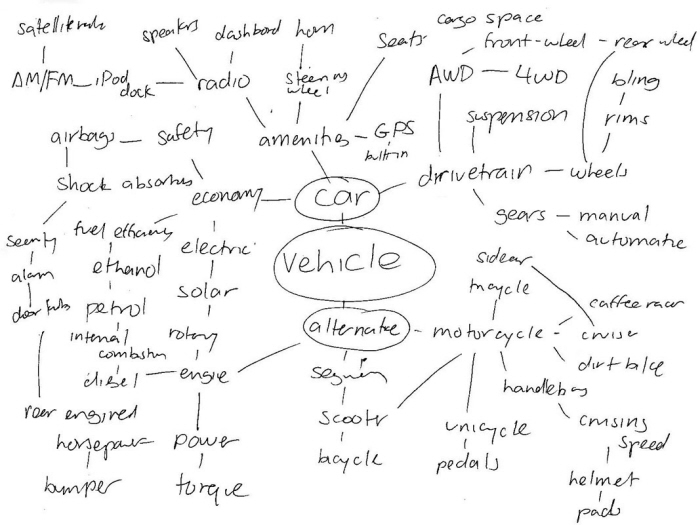
LT-35 - The LT-35 (35 = 3 wheel, 5 passenger) is an electric tricycle/tuk-tuk replacement for urban environments in the Philippines and other developing countries.
It utilizes a Li-Ion powered motor geared to a "reverse" three-wheel configuration and an easy plug-in charging system.
When used as part of a citywide public transportation system, it not only provides a smaller air pollution footprint after manufacture but can also ease noise pollution in crowded urban environments.

The first stage of the LT-35 design process involved creating special flowcharts called mind maps. Each item on the mind map is directly related to the one next to it, and is intended to represent a raw brainstorm to determine what could work on the intended design.


Visual Table - I then came up with a visual table where I would list every design I felt would be relevant to the intended concept - relevant or otherwise.
Three-wheeled vehicles and/or tuk-tuks took precedence as I intended to distinguish the concept from the electric jeepneys that were also popular during the time.

Where multiple electric jeepneys had already been proposed, I decided to approach the Philippines' other mode of transport: the sidecar tricycle.

I had intended to make the LT-35 a three-wheeled vehicle from the beginning, but at the same time keep it distinguishable from the ubiquitous tuk-tuk in use elsewhere in Asia. As a result I decided to implement a reverse drivetrain, using a low center of gravity to ensure stability.
Above the drivetrain, I wanted to maintain the overall look of the sidecar while providing a safer package that would be more friendly to the environment.

In terms of interior amenities, I wanted the driver to have at least the same basic amenities of a public utility vehicle. At the same time, I needed to make sure the driver was more protected from hazards around him than he would on a normal tricycle - or rather, the motorcycle used on the sidecar.

When designing the LT-35's interior, I explored whether to retain the familiar motorcycle handlebars used on the existing sidecar configuration or go for a more car-like configuration with a steering wheel.
The LT-35 also had to feature amenities to support the driver as a business function, as well as the passenger.

As sidecar tricycles are known for being notoriously overloaded, I decided to create ample room for passengers to sit while at the same time ensuring that the stability of the sidecar was not compromised. They needed to be able to hop on and off with ease, and at the same time be reasonably protected from the environment around them.


Using 3DS Max 2008 I created a rendering of the LT-35. I used a fairly simple overall shape while still taking aesthetic and safety concerns into account as compared to the sidecar tricycle the LT-35 would replace.


With help from a teacher, these 3DS Max renderings were organized into an AutoCAD orthographic drawing.

I then used 3DS Max and Photoshop to import the rendering of the LT-35 into typical Manila environments to simulate how it would appear during daily use.


A rendering of the LT-35's interior dashboard at night. Each gauge uses simple, readily-available parts and includes LED lighting to reduce overall cost in energy usage.
3DS Max 2008.

As part of the prerequisites for the 2010 Transport Design Competition, I would further expand the LT-35 to include a charging system that was suited to the urban environments of the Philippines. I experimented with different plug-in layouts, as space requirements vary wildly in different parts of the same city.



I also experimented with different sources of power. I was primarily drawn to solar power due to the increasing availability and affordability of solar power sources for developing countries.

I ultimately settled on a one-stop plug-in hub directly inspired by the "spark hydrants" from the Watchmen graphic novel. These "spark trees" would be placed at strategic locations around Manila for easy, quick charging while taking up relatively less space than a wall array.

As part of the Transportation Design Contest in 2010, I was required to come up with a set of promotional graphics for my vehicle, as well as a video to promote it. To avoid bias, I was not allowed to put anything on it that would identify me personally, so I used the LaZardo pseudonym.





PIMS Model Construction - Finally, the competition required the construction of a scale model that would resemble the final product. This one was constructed primarily of plastic foam board.
The miniscule LT-35 won 2nd Place at the competition, against 20 other concepts for cars, trucks, buses, and trains.
gLike